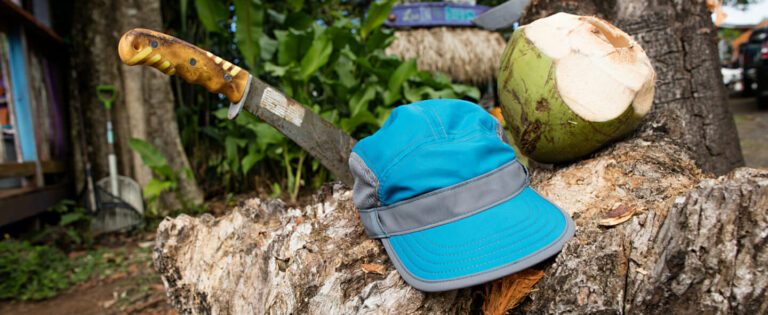UV protection. Ever heard of it? Why, of course you have! From all those sunscreen adverts and going on holiday to the beach with mum and dad, right? Well, back then you may not have cared so much or really taken heed of what mum was saying. But now that we’re all grown up, the wise words of our elders ring loud and true: UV rays can be very harmful! And, since we’re all outdoor athletes of some kind, we’re constantly exposed to varying weather conditions and UV rays of varying intensities.
Since our skin is unable to provide enough protection against the sun over long periods and you’re probably not planning on cycling around, climbing mountains or kayaking with a parasol at the ready, your clothing is the only thing left to protect you from harmful UV rays. Unfortunately, most of the textiles the outdoor industry brings to market don’t provide effective protection. And since you presumably won’t be able to simply look at a garment and say whether or not you’ll get the necessary UV protection, we’re here to give you all the important info on the Ultraviolet Protection Factor (UPF), UV Index as well as the standards and the corresponding testing procedures for textiles.
The type of fabric
For a start, you should know what fabric is capable of giving you effective protection. Both synthetic fibres as well as cotton and wool garments can protect you from UV rays. And, chemicals don’t necessarily have to be involved! The most crucial aspect is how finely woven a garment is. The more finely woven the garment, the less harmful UV rays can get through. For example, a conventional white cotton shirt hardly provides any UV protection when wet. Very thin merino wool, on the other hand, provides a high level of natural protection from the sun’s rays (25-50+). Special UV protection clothing can even absorb up to 98% of all UV rays. What does all this mean in real life? Well, we’ll tell you all about it in the next section.
Factoring in the Ultraviolet Protection Factor
As a general rule, we can say that with every 1000 metres increase in altitude, UV levels increase by about 10-12%. Plus, snow, water and sand all reflect sunlight and UV radiation to a certain extent. Where you are at what time of year and at what time of day all play a significant role as well. This can all be wrapped up by the term UV Index. This is an international standard measurement of the ultraviolet radiation levels on a 1-11+ scale that determines the appropriate Ultraviolet Protection Factor (UPF) depending on your skin type.
As you’ve probably already gathered, UPF stands for Ultraviolet Protection Factor, the term manufacturers use for their sun-protective clothing. The UPF is indicated on a scale of 0-80. A fabric with a UPF 50 rating means that only 1/50th of the UV radiation will go through it, thereby reducing the skin’s exposure to UV radiation by 50 times.
Another example: If you have light skin, the time you can spend out in the sun at the top of a mountain (naked) without damaging your skin is 10 minutes. With a full-body costume that boasts a UPF 50 rating, the time would increase by 50 times that. The result: You can expose yourself to the blazing sun for 490 minutes longer. Great! But is it really that simple? Yes it is, provided that the tests were carried out “properly”!
What is tested and whose is the most reliable?
The Ultraviolet Protection Factor (UPF) can be determined in several different ways. However, you have to keep in mind that clothing, and sun-protective clothing in particular, is exposed to constant wear and extreme weather conditions. And, this can cause textiles to lose the better part of their original protection factor! Another thing you should consider is the fact that the intensity of the sun’s rays greatly depends on where you are.
This is why the textile industry has different standards that reveal – at least to a certain extent – what the sun protection factor of your new garment is. In the following, we’re going to talk about what kind of standards there are and how reliable they are:
The European Standard EN 13758-1
The tests are carried out on new textiles, that is, in the condition they were when they came from the manufacturer. This means that the wear that comes with washing and wearing the garment is not taken into consideration in these tests, which is honestly not that helpful for us outdoor enthusiasts! The European standard uses the sun spectrum of Albuquerque, New Mexico, as this corresponds to that of Southern Europe.
The American Standard AATCC 183
This method corresponds to the European standard for the most part. Unworn garments are tested, and the sun spectrum of Albuquerque, New Mexico is used. So, the American standard is just as moderately useless as the European one.
The Australian/New Zealand Standard AS/NZS 43999:1996
This standard is based on the sun spectrum in Melbourne in January, since the radiation intensity in the northern hemisphere is different from that in Australia. The measurements are carried out only on ‚as new‘ textiles, so many important factors are not taken into consideration. For this reason, it’s not really a reliable criterion for you to base a decision on.
The UV Standard 801
You’re probably thinking: “There must be some reliable standard out there!” Well, you’re in luck: the UV Standard 801. Who would’ve thought? Take the maximum radiation intensity, that is the sun spectrum at the height of the Australian summer, simulate usage conditions by washing the garment and using a certain method to stretch it out. Then, the Ultraviolet Protection Factor (UPF) of a garment that is wet during the measurement can be determined. A garment that complies with the standard gets its very own hangtag that reliably states how high the UPF rating is .
In other words: The fact that sun protection is crucial for reducing the risk of skin disease is nothing new under the sun (pun intended). Special sun-protective clothing can provide reliable protection, provided that the measurement is reliable as well. So, if you’re planning a trip to a place where you’ll be exposed to a lot of sunlight, this is something you should really consider buying. And, as always, the price should not be the determining factor when choosing between one garment and another. Instead, the UV Standard 801 should be!
Among our many brands, the company Hyphen, for example, offers a large selection of children’s clothes that comply with the UV Standard 801.
The European standard provides sufficient guidance for our latitudes and the corresponding sunlight. However, it should be taken into account that the UV protection applies to new textiles!








